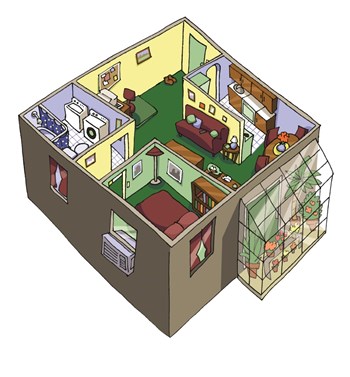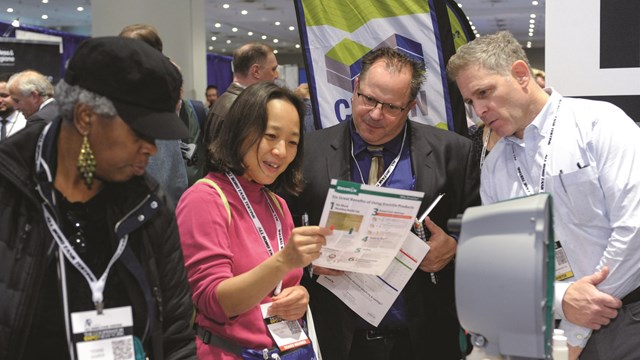
The key to achieving savings in your home is a whole-house energy efficiency plan. To take a whole-house approach, view your home as an energy system with interdependent parts. For example, your heating system is not just a furnace—it's a heat-delivery system that starts at the furnace and delivers heat throughout your home using a network of ducts. Even a top-of-the-line, energy-efficient furnace will burn a lot of fuel if the ducts, walls, attic, windows, and doors are not insulated and leak. Taking a whole-house approach to saving energy ensures that dollars you invest to save energy are spent wisely.
Energy-efficient improvements not only make your home more comfortable, they can yield long-term financial rewards. Reduced utility bills more than make up for the higher price of energy-efficient appliances and improvements over their lifetimes. In addition, your home could bring in a higher price when you sell. An easy, practical solution for saving energy can be found throughout your home—from the roof, walls, and insulation that enclose it to the appliances and lights inside.
A condominium complex, no matter its size, operates the same way, albeit on a larger scale. If individual unit owners move collectively and cooperatively to reduce energy costs and increase efficiency, the complex will, by extension, achieve the same result. In fact, because many condo complexes have shared walls, the net reduction in energy could be even greater.
Here are 10 things HOAs can do to encourage individual unit owners to conserve energy and to help the overall complex save too.
Set the Tone
Just as the CEO of a company sets the tone for the entire organization by expressing his or her priorities, so an HOA has the power to influence how its individual unit owners behave. A CEO who is openly reckless and unafraid of risk will engender the same sort of behavior in his or her employees. The same goes with the HOA. If the board emphasizes awareness and proactivity with respect to energy conservation, the unit owners are more likely to follow suit.
Form an Energy Committee
Boards form committees for all kinds of lifestyle-related things: membership, aesthetics, recreation, and so forth. Why not an energy/environmental study committee? Is this a good idea? “Yes,” says Laurel Elam, program manager for the Residential Energy Services Network, or RESNET, “because sustainability can overreach into the other committees—finances, pool, architectural review.” Often, unit owners would like to save energy but don’t know how. The committee can offer practical suggestions on how to achieve these goals.
Make a Game of It
“Have a ‘challenge the board’ contest where the board’s average energy use and/or recycled items are compared to the homeowners in the community,” suggests Elam. “If they have common facilities, start saving energy there first. Put placards throughout showing the ways the building is saving energy.” Indeed, making it into a contest not only makes it more fun, it creates incentive beyond the bottom line. We all want to keep up with the Joneses. Competition can take advantage of the basic American desire to one-up our neighbor. “I saw this be successful in dorm settings at Appalachian State,” she says.
Change Your Bulbs
“Change out incandescent light bulbs with more energy-efficient lighting choices,” recommends Stacy Kika of the U.S. Environmental Protection Agency’s (EPA) Energy Star program. “Energy Star qualified lighting not only uses less energy, but also produces approximately 75 percent less heat than incandescent lighting, so cooling bills will be reduced, too.” In a big condominium complex, this translates into tangible savings.
Maintain Your Filters
“Check your cooling system’s air filter every month,” says Kika. “If the filter looks dirty, change it. A good rule is to change the filter at least every three months. A dirty filter will slow air flow and make the system work harder to keep you cool—wasting energy.” The difference in cost between a new filter and cooling a complex with a dirty one can be profound.
Assess Your Settings
Are the common areas in the complex too hot in the winter, or too cool in the summer? This is something that the board can change. Individual unit owners can do likewise in their units. “If you have a programmable thermostat, program it to work around your family’s summer schedule,” Kika says. “Set it a few degrees higher (such as 78 degrees) when no one is home, so your cooling system isn’t cooling an empty house.”
Seal Those Cracks
Although all buildings need some flow of air in order to “breathe,” many structures, especially older ones, have cracks where air escapes. The concept here is simple: you want to retain as much cool air as possible in the summer and as much warm air as possible in the winter. The best way to do this is get some DIY spray foam and, ahem, get cracking.
“The biggest bang for the buck is air sealing—sealing up all the cracks to the outside,” says Jamie Peters, program manager for the Midwest Energy Efficiency Alliance. “The savings can be big by improving air sealing.” One common place to locate a crack: underneath the vanity in the bathroom, where the pipes come up from the floor.
“As much as 20 percent of the air moving through your home’s duct system is lost due to leaks and poor connections,” Kika notes. “Seal duct work using mastic sealant or metal tape and insulate all the ducts that you can access (such as those in attics, crawlspaces, unfinished basements, and garages). Also, make sure that connections at vents and registers are well-sealed where they meet floors, walls, and ceilings. These are common locations to find leaks and disconnected ductwork.”
Retrofit!
If you live in an old complex, there might be some walls that have insufficient insulation. It’s not necessary to rip that wall down to properly insulate it. Contractors can use “dense pack” insulation to fill in those gaps, which requires a few holes be drilled into the wall. But this is not a do-it-yourself scenario. “For professionals, we recommend homeowners look for certification from BPI—the Building Performance Institute,” says Peters. “Vendors that have this certification are more up to speed.”
Get Shady
If you read Victorian-era novels, you know that in the olden days, servants spent a good deal of time drawing drapes, opening windows, and closing windows, at various strategic intervals during the day. This was once a basic need, but its logic has been overshadowed in the age of air conditioning. But people did this for a good reason, and that reason has not changed. “Pull the curtains and shades closed before you leave your home to keep the sun’s rays from overheating the interior of your home,” Kika says. “If you can, move container trees and plants in front of sun-exposed windows to serve as shade.”
This is common sense, but then, so are many of the items on this list: extensive use of the oven can turn a hot unit into a sweltering one. The time to bake cookies is when the mercury drops. “Use a microwave instead of an oven to cook, when you can,” Kika suggests. “Ovens take longer to cook food and can make your house warmer, requiring you’re AC system to turn on to keep the house at a comfortable temperature.” In the winter, there is a converse effect: baking helps heat the house and keep it warm.
Get Rated
There are a number of independent energy consulting companies who specialize in helping commercial companies and residential communities save money by reducing energy costs. Every condominium is different, and these experts are adept at finding ways unique to your building to conserve energy and save money. “Hire a rater,” says Elam, “and have the energy efficient features verified by a third party.”
Until an enterprising genius figures out a way to generate super-cheap power by harnessing the sun’s rays, we will be in a constant quest to conserve energy. Using this list will not bring these costs to zero, of course, but they will help. And if everyone pitched in, imagine the savings!
Greg Olear is a freelance writer and a frequent contributor to The Chicagoland Cooperator.






Leave a Comment